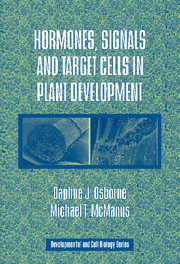Book contents
- Frontmatter
- Contents
- Preface
- 1 Introduction
- 2 Hormones and Signals: Identification and Description of Signalling Molecules
- 3 Cell-to-Cell Signalling: Short and Long Distance
- 4 Population Diversity of Cell Types and Target Identification in Higher Plants
- 5 Flexibility of Cell Types and the Target Cell Status
- 6 Terminally Committed Cell Types and the Target Status
- 7 The Mechanisms of Target Cell Perception and Response to Specific Signals
- 8 Hormone Action and the Relief of Repression
- 9 The Phenomenon of Hormonal Cross-Talk
- References
- Index
3 - Cell-to-Cell Signalling: Short and Long Distance
Published online by Cambridge University Press: 06 August 2009
- Frontmatter
- Contents
- Preface
- 1 Introduction
- 2 Hormones and Signals: Identification and Description of Signalling Molecules
- 3 Cell-to-Cell Signalling: Short and Long Distance
- 4 Population Diversity of Cell Types and Target Identification in Higher Plants
- 5 Flexibility of Cell Types and the Target Cell Status
- 6 Terminally Committed Cell Types and the Target Status
- 7 The Mechanisms of Target Cell Perception and Response to Specific Signals
- 8 Hormone Action and the Relief of Repression
- 9 The Phenomenon of Hormonal Cross-Talk
- References
- Index
Summary
Despite enormous biological diversity, uniformity within a species remains remarkably constant. Trees can be instantly recognised by their shape or form, and leaf and flower structures are a basis of identification and classification. Roots conform to each species expectation, and the natural mutant that does not conform to the species type is a rarity.
This means that the society of cells that make up the plant body is under very strict control. No one branch can outgrow its neighbours and distort the overall shape of the tree. The buds that are terminal on any branch keep pace with, but do not outstrip those on the neighbouring branches. The phenomenon of apical dominance, used by crop growers from time immemorial as the basis to reshape by pruning or to improve yields, is intertissue signalling at its most evident. The consistency with which lateral buds will grow when the terminal bud is removed is central to plant culture and pruning systems throughout the world. Not until Frits Went demonstrated the presence of a chemical substance (indole-3-acetic acid) in Avena coleoptile tips and then showed that it would replace the terminal bud in inhibiting the growth of laterals was the first intertissue signal molecule properly established. With the knowledge that the auxin molecule is transported in a polar fashion from cell to cell as it passes from terminal bud to tissues below, it is not difficult to understand how a terminal bud can control the growth of fellow buds below over distances that are relatively short.
- Type
- Chapter
- Information
- Hormones, Signals and Target Cells in Plant Development , pp. 42 - 75Publisher: Cambridge University PressPrint publication year: 2005



